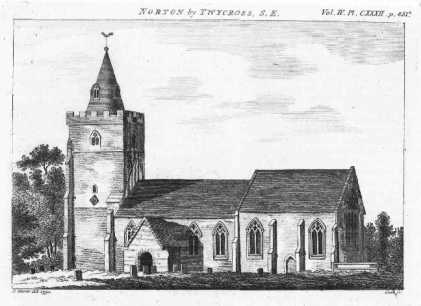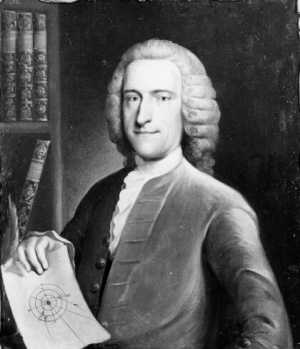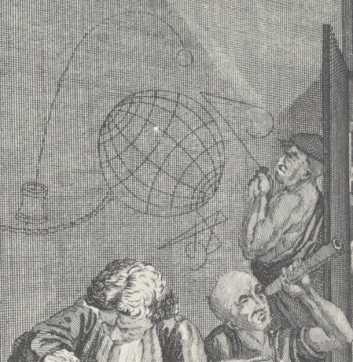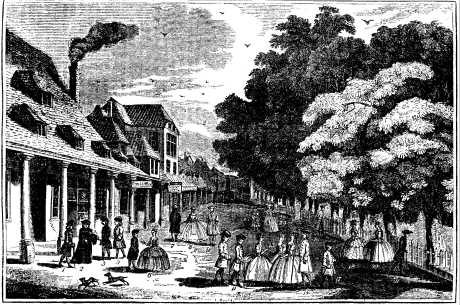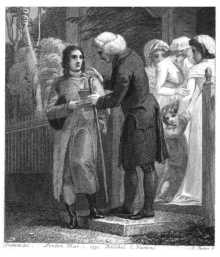William Whiston (1667–1752)
|
William Whiston was born at Norton-juxta-Twycross, Leicestershire where his father, Josiah Whiston (1622–1685), was Rector from 1661-1685. He attended Queen Elizabeth Grammar School, Tamworth, Staffordshire and then Clare College, Cambridge, where he studied mathematics. He resigned his Fellowship in 1699 to marry Ruth Antrobus, the daughter of his headmaster at Tamworth School. He died in 1752 at Lyndon Hall, Rutland, his daughter and son-in-law's residence. Click on image for larger version. |
A New Theory of the Earth, 1696.
|
William Wigston with a diagram illustrating his theories on cometary catastrophism.
Click on image for larger version. Some pages from the fifth edition of A New Theory of the Earth. |
In this book, Whiston sets out his ideas on the formation of the Earth. It has to be consistent with the creation story in Genesis, except that the people who wrote the Old Testament did not have the astronomical knowledge of Whiston's own time. The book is over 400 pages long and discusses many aspects of the Earth. Whiston says that astronomical objects existed before the creation of the Earth in Genesis, and were moved to their current locations at the time of Genesis. Before the deluge the was Earth perfect sphere in a circular orbit. There were no oceans, only lakes and rivers (p358, p370 and others). The air was thinner, with no rain, storms, thunder or lightning, the ground was watered by mists (p365). There were no rainbows (p367). He writes that the water for forty days and forty nights of rain described in the Biblical flood came from Earth passing through the tail of a comet. The rest of the water came from the Fountains of the Great Deep. The encounter with the comet also changed the shape of both the Earth and its orbit, and caused seasons and changeable weather, and the first rainbow. Although the "dirty snowball" idea dates from 1950, suggested by Fred Whipple, water was not observed in a comet until 1986 in Comet Halley, using the International Ultraviolet Explorer. It is estimated that it lost 1.5 x 108 tons (1.36 x 108 tonnes) of water between September 1985 and the beginning of July 1986. There are about 1.54 x 1018 tons (1.4 x 1018 tonnes) of water on the surface of the Earth. Research showed that the water in Comet Hartley 2 is the same as that in the Earth's oceans. (Clavin and Perrotto, 2011). However, other results, such as from Rosetta (Altwegg et al, 2015), suggest that Earth's water may not have come from comets after all. Immanuel Velikovsky, author of the now discredited Worlds in Collision, 1950, was aware of the work of William Whiston. Velikovsky also described a comet causing catastrophes on Earth. He claimed it had been ejected by Jupiter and later became the planet Venus. |
Religious Views
He succeeded Isaac Newton as Lucasian Professor of Mathematics at Cambridge University from 1702 until 1710, when he was expelled from the university, because of his religious views. He supported a return to the early days of the church and also Arianism: following the teachings attributed to Arius (ca. AD 250-336). Arius, in saying that Christ did not always exist, made him inferior to God. [This is nothing to do with the concept of an Ayrian race.] The university rules stated that he must not teach anything that disagreed with Anglican doctrine. Whiston also published his beliefs. It is possible that, had he only written in Latin, he would have had fewer difficulties, because only academics would have read his work. Another consequence was that, although he lectured at the Royal Society, he was never invited to become a Fellow.
Teaching
In 1711 he moved to London, having to make a living, and gave a variety of lectures, both with partners and alone. His astronomical teaching included a course on astronomy (with Francis Hauksbee the younger (1687–1763)), and lectures on astronomy in coffee shops. He would give talks after astronomical phenomena occurred such as aurora and eclipses. He sold charts of the solar system and the 1715 and 1724 solar eclipses.
Board of Longitude
He became involved with finding better ways to calculate longitude at sea. In 1714, with Humphrey Ditton (1675-1715), he petitioned Parliament for a reward for a reliable method of finding longitude. Newton, Cotes, Clarke and Halley intervened. Whiston and Ditton published a broadsheet on the subject. That year, the Longitude Act was passed. This resulted in the creation of the Board of Longitude, whose members included William Ludlam (c1717-1788) later in the eighteenth century.
|
A detail from the 1735 version of the engravings of Hogarth's The Rake's Progress: Plate 8 "In the Madhouse".
|
The drawings on the wall show one of Whiston's methods of determining longitude. He suggested having a line of ships at fixed points across the ocean. They would fire a star shell at the same time each day. The distance of the shell would be calculated using the time taken for the sound to arrive after the flash of light was observed. He also suggested a method using variations in magnetic declination. The paintings and engravings of Hogarth's A Rake's Progress differ. In 1763 Hogarth added the Britannia emblem to the engraving of "In the Madhouse" which covered some of the mathematical diagrams. Note: Hogarth's work is political rather than scientific! Click on image for larger version. |
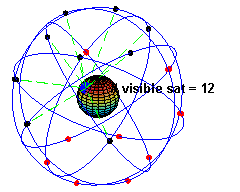 The orbits of satellites for the Global Positioning System (GPS)
| The Global Positioning System (GPS) uses the time taken for a signal to travel from satellites to the ground to determine a location. Whilst this is not the same as William Whiston's proposal, both make measurements by timing signals. (From: Wikimedia Commons) |
Astronomical Publications
Praelectiones Astroniomicae Cantabrigiae in Scholis Publicis Habitae, 1707,
Astronomical Lectures read in the Public Schools at Cambridge [English Version], 1715.
Praelectiones physico-mathematicae, 1710, a more accessible version of Newton's Principia.
Sir Isaac Newton's Mathematick Philosophy More Easily Demonstrated [English Version], 1716.
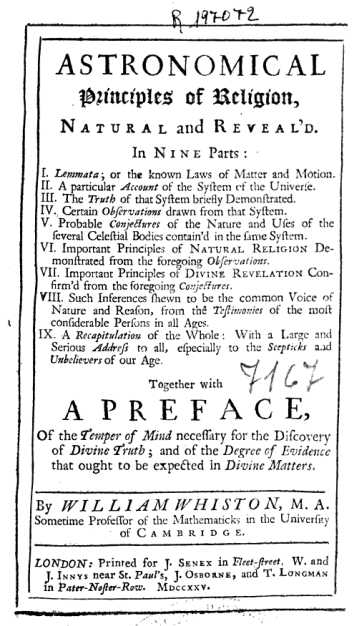
The title page of Astronomical Principles of Religion, William Whiston, 1725.
|
As well as religion Astronomical Principles of Religion includes chapters on astronomy, for example: a diagram showing "The Copernican or true Solar System" opposite p34, "A Map of the Moon", opposite p67, drawings of Jupiter and Saturn, opposite p71. comets are members of the solar system p74, the fixed stars are much further away and of the same nature as the Sun p78 Click on image for large version. |
Tunbridge Wells
|
Engraving based on a drawing by Samuel Richardson of visitors to Tunbridge Wells in 1748
|
The engraving on the left is based on a drawing by the novelist Samuel Richardson (1689–1761) of people in Tunbridge Wells in 1748. Dr. Johnson is on the extreme left and Whiston on the extreme right, walking away from the others. From: The Mirror of Literature, Amusement, and Instruction, August 1, 1829. Click on image for larger version. |
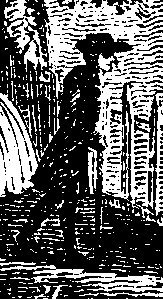 Detail showing William Whiston.
|
In a letter, Richardson writes:
|
Thomas Barker, grandson
About 1715 William Whiston's daughter, Sarah, married Samuel Barker (1686–1759) of Lyndon, Rutland. Their son, Thomas Barker (1722–1809) was born at Lyndon Hall and married Anne, one of the sisters of Gilbert White (1720–1793).
Thomas made meteorological observations at Lyndon from the age of about eleven, which have been used to study the Little Ice Age (a period of cooling after the Medieval Warm Period). Some of his observations were published in the Philosophical Transactions of the Royal Society. He was not a Fellow of the Royal Society, so the observations were submitted in Barker's name by Fellows, including Gilbert White's brother, Thomas. In 1755 (49 pp347-50) part of a letter Barker wrote to James Bradley was published in Philosophical Transactions. It concerned the return of a comet seen in 1531, 1607 and 1682. It was expected again in 1757 or 1758. Although it is not yet named, this was Halley's Comet. Thomas Barker published a book, An Account of the Discoveries Concerning Comets in 1757.
The Vicar of Wakefield, Oliver Goldsmith
|
Illustration from The Vicar of Wakefield, Oliver Goldsmith, 1792.
|
The character of Reverend Dr Charles Primrose in The Vicar of Wakefield by Oliver Goldsmith, (published in 1766) was probably based on William Whiston. Click on image for larger version. |
References
Altwegg K. et al, 67P/Churyumov-Gerasimenko, a Jupiter family comet with a high D/H ratio (Abstract), Science 23 January 2015: Vol. 347 no. 6220. Published online December 10, 2014.
Clavin, Whitney and Perrotto, Trent, Space Observatory Provides Clues to Creation of Earth's Oceans, NASA, 5 October, 2011.
Fara, Patricia, Fatal Attraction - Magnetic Mysteries of the Enlightenment, 2005, pp51-6, 64.
Feldman, P. D., Festou, M. C., Ahearn, M. F., Arpigny, C., Butterworth, P. S., Cosmovici, C. B., "IUE observations of Comet Halley: Evolution of the UV spectrum between September 1985 and July 1986", ESA Proceedings of the 20th ESLAB Symposium on the Exploration of Halley's Comet, Volume 1: Plasma and Gas p 325-328: p328
Force, James E., William Whiston: Honest Newtonian, 1985. Limited preview.
Goldsmith, Oliver, The Vicar of Wakefield, 1792 edition.
Hogarth, William, A Rake's Progress, Plate 8 (Orig, unfinished) [png]
Inkster, I., "Advocates and audience - aspects of popular astronomy in England, 1750- 1850", Journal of the British Astronomical Association, vol.92, no.3, p.119-123. William Whiston is mentioned on p119)
Lucasian Chair.org: William Whiston
Mirror of Literature, Amusement, and Instruction, The, Vol. 14, Issue 383, August 1, 1829, pp66-8: "Tunbridge Wells". Engraving of William Whiston based on a drawing by Samuel Richardson.
Nichols, John, The history and antiquities of the county of Leicester: Vol. 4, Part 2, 1811. p852, drawing of church, p851
Physics Factbook, The: Mass of the Oceans
Snobelen, Stephen D., 'Whiston, William (1667–1752)', Oxford Dictionary of National Biography, Oxford University Press, 2004; online edn, Oct 2009 [http://www.oxforddnb.com/view/article/29217, accessed 29 September, 2012]
Velikovsky, Immanuel William Whiston and the Deluge
Whiston, William, Memoirs of the life and writings of William Whiston : containing memoirs of several of his friends also, 1753.[Rare books, University of Leicester Library]
Waites, Bryan, editor, Who Was Who In Rutland, Rutland Record Society, 1987.
Last updated 30th December, 2015.

